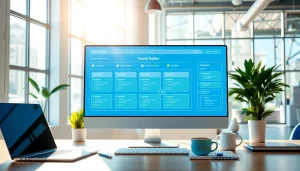Understanding Funnel Builders
What Are Funnel Builders?
Funnel builders are digital tools designed to help businesses create structured processes for acquiring customers, managing leads, and ultimately driving sales. These platforms streamline the steps from a potential customer’s first interaction with a brand to the point of purchase, covering every stage of the sales funnel. By simplifying the funnel creation process, these tools reduce the need for advanced technical skills, enabling marketers and entrepreneurs to create high-converting sales funnels effectively. With the increasing importance of customer experience and online sales, mastering funnel builders is essential for any aspiring business owner or marketer.
Importance of Funnel Builders in Digital Marketing
In today’s competitive digital landscape, having a well-defined sales funnel is crucial. Funnel builders simplify this by providing templates, analytics, and automated solutions. They allow businesses to efficiently manage their marketing efforts, organize campaigns, and analyze performance metrics. Moreover, these tools enhance user experience by providing targeted messaging at various stages of the customer journey. A well-designed funnel not only improves conversion rates but also contributes to customer retention and brand loyalty. As such, Funnel Builders are invaluable for anyone looking to maximize their marketing efforts and achieve sustainable growth.
Key Features to Look for in Funnel Builders
When selecting a funnel builder, it is important to evaluate several key features that will enhance functionality and ease of use. Here are some essential features to consider:
- User-Friendly Interface: A simple drag-and-drop editor can significantly reduce the learning curve for users.
- Integrations: Look for tools that seamlessly integrate with your existing marketing stack, including email providers, CRM systems, and payment gateways.
- Analytics and Tracking: Robust reporting features allow you to monitor funnel performance and make data-driven decisions.
- Customization Options: The ability to customize templates and workflows ensures that your funnels reflect your brand identity.
- Responsive Design: With an increasing number of users accessing websites on mobile devices, mobile responsiveness is critical for conversion.
- A/B Testing Capabilities: Built-in testing tools enable optimization based on real-time data.
Setting Up Your First Funnel
Choosing the Right Funnel Builders for Your Business
Choosing the right funnel builder is pivotal to achieving your business goals. Begin by assessing your specific needs, including the complexity of your sales process, integration requirements, and budget constraints. For smaller businesses, user-friendly and cost-effective options are ideal, while larger enterprises might need more advanced features. Evaluating user reviews, joining online communities for shared experiences, and taking advantage of free trials can provide valuable insights into the performance of various funnel builders. This due diligence will help you find a solution tailored to your unique business demands.
Step-by-Step Guide to Building Your First Funnel
Building a sales funnel can be a straightforward process if approached methodically. Here’s a step-by-step guide:
- Identify Your Goal: Define what you want to achieve, whether it’s generating leads, making sales, or enhancing engagement.
- Select a Template: Most funnel builders provide a variety of templates tailored for different objectives. Choose one that aligns with your goal.
- Customize the Funnel: Use the editing tools to adjust the visual elements, including colors, images, and text to match your brand identity.
- Add Essential Components: Integrate features like opt-in forms, payment gateways, upsell options, and email sequences to enhance user experience.
- Set Up Tracking: Implement tracking codes and analytics to monitor user behavior and funnel performance.
- Test Your Funnel: Before launching, ensure to test every element of the funnel to identify potential issues and make necessary adjustments.
- Launch and Monitor: Once satisfied with the setup, launch your funnel and keep an eye on the analytics to optimize performance.
Integrating Other Tools with Funnel Builders
Integration capabilities are a defining feature of effective funnel builders. To maximize their value, connect them with relevant external tools that streamline your operations. For instance, linking your funnel builder to customer relationship management (CRM) tools can enhance lead tracking, while email marketing platforms can automate communications based on user actions within the funnel. Additionally, integrating analytics tools can provide deeper insights into user behavior, allowing for more targeted marketing strategies. These integrations facilitate a smoother workflow, ensuring that every aspect of the funnel operates in harmony.
Optimizing Your Funnel for Conversions
Best Practices to Enhance Conversion Rates
Optimizing conversion rates is the ultimate objective of any sales funnel. Here are some best practices to ensure your funnel performs at its best:
- Clear Call-to-Actions (CTAs): Ensure that CTAs are prominent and clearly instruct users on the next steps.
- Value Proposition: Clearly communicate the value your offer provides, making it irresistible to potential customers.
- Minimize Distractions: Keep the design clean and focused on the CTA; avoid unnecessary information that could confuse users.
- Build Trust: Incorporate testimonials, reviews, and security badges to instill confidence in your potential customers.
- Utilize Exit-Intent Popups: Capture potential customers before they leave by offering discounts or additional value.
Use of A/B Testing in Funnel Builders
A/B testing is a powerful tool for conversion optimization in funnels. By systematically comparing two versions of a funnel component, you can determine which performs better with your audience. This can include testing different headlines, button styles, or layouts. Not only does this provide insight into customer preferences, but it also allows you to make data-backed decisions that enhance overall funnel performance. Be sure to test one variable at a time and measure results over a sufficient period to account for variability.
Analyzing Data for Continuous Improvement
The effectiveness of a funnel hinges on continuous improvement through data analysis. Regularly review analytics to track key performance indicators (KPIs) such as conversion rates, abandonment rates, and user engagement metrics. These insights can guide adjustments to your funnel design, messaging, and even pricing strategies. Additionally, segmenting data based on user demographics can help tailor marketing efforts more precisely, leading to more personalized customer experiences and higher conversion rates.
Advanced Funnel Building Techniques
Automation in Funnel Builders
Automation is a game-changer in the funnel building process. By setting up automated email sequences, follow-ups, and customer workflows, you can nurture leads without demanding constant manual input. Automation allows for real-time responses to user actions, enhancing user experience and improving the likelihood of conversions. Moreover, automated systems can handle tasks such as lead scoring and segmentation, streamlining your marketing efforts and focusing resources on high-potential leads.
Leveraging Customer Segmentation
Customer segmentation is the practice of dividing your audience into specific groups based on characteristics such as demographics, behaviors, and preferences. By understanding these segments, you can tailor your marketing messages and funnel pathways to align with each group’s interests. For instance, creating personalized experiences for different customer segments can improve engagement rates and increase conversions. This targeted approach not only enhances customer satisfaction but also maximizes the effectiveness of your marketing spend.
Integrating Advanced Analytics for Better Insights
Advanced analytics offer a deeper understanding of customer behaviors and funnel performance. Utilizing tools such as heat maps, user session recordings, and multi-channel attribution can reveal valuable insights that standard analytics may miss. By understanding how users interact with each element of your funnel, you can identify problem areas and optimize them for better performance. Additionally, advanced analytics can track customer journeys across different channels, enabling a more holistic approach to marketing strategies.
Choosing the Right Funnel Builder for Your Needs
Comparative Analysis of Top Funnel Builders
Conducting a comparative analysis of top funnel builders can guide you in making an informed choice. When analyzing different tools, consider factors such as usability, pricing, feature sets, and customer support. Evaluating case studies or testimonials from existing users can also provide valuable context regarding the effectiveness of specific funnel builders. A detailed comparison can help you to select the best fit for your business goals and budget.
Cost vs. Value of Popular Funnel Builders
Understanding the cost versus the value provided by funnel builders is critical to maximizing your ROI. While some tools may appear less expensive upfront, they may lack crucial features that propel conversions. Conversely, more expensive options might offer an array of functionalities that lead to greater long-term benefits. It is essential to consider not only the direct costs but also the potential performance enhancements associated with the investment. A thorough analysis of the features relative to their pricing will enable you to find a cost-effective solution that meets your business needs.
Making an Informed Decision on Funnel Builders
Making an informed decision about which funnel builder to use is key to your success. Take into account your specific business goals, budget considerations, and the unique needs of your audience. Testing various platforms through demos or free trials can provide clarity on their usability and effectiveness. Furthermore, seeking feedback from peers or communities can reveal hidden advantages or pitfalls that might not be apparent in standard marketing materials. With the right funnel builder in place, your business can effectively drive engagement, conversions, and growth.








